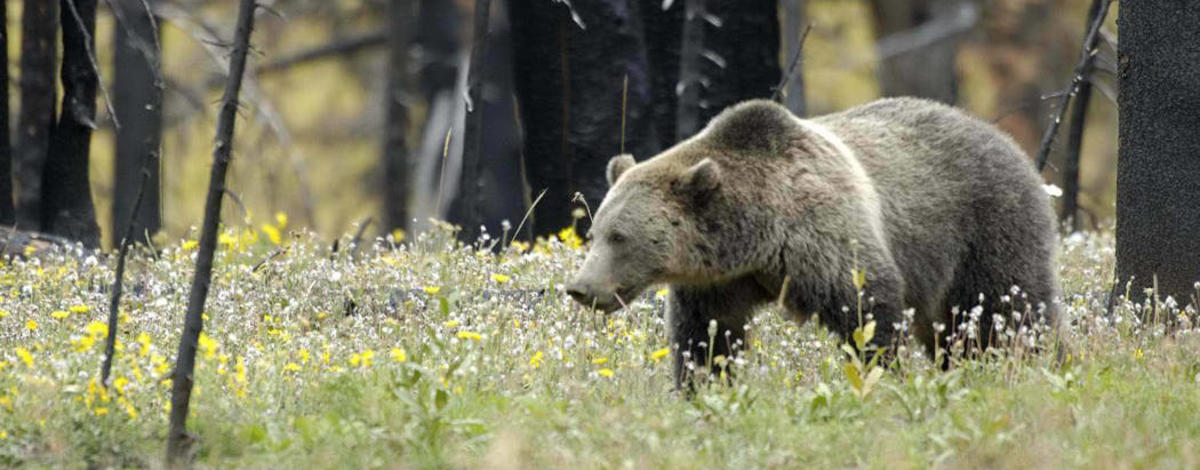Idaho Fish and Game commissioners on Thursday, May 10 approved a hunting season for grizzly bears in a portion of eastern Idaho with one tag offered.
The Greater Yellowstone Ecosystem grizzly bear population has met federal recovery criteria since the early 2000s. The state of Idaho and its professional wildlife managers played a key part in this population’s recovery, in partnership with other states, and federal, tribal and local governments. In 2017 the U.S. Fish and Wildlife Service took the population off of the Endangered Species Act list, and Idaho will continue to responsibly manage the population in coordination with Wyoming and Montana now that federal protections are lifted.
The conservation strategy for the Greater Yellowstone Ecosystem grizzly population includes hunting as a management tool when the population is more than 600 bears.
The 2017 population estimate is 718 grizzly bears in the greater Yellowstone “demographic monitoring area” (DMA), which encompasses suitable grizzly habitat in Idaho, Wyoming and Montana. The DMA includes all of Yellowstone and Grand Teton National Parks, but no hunting will occur in either national park. The population in the DMA has been stable over the last decade with annual population estimates in the monitoring area ranging between 694 and 757 grizzlies.
Idaho grizzly bear hunt
Fish and Game will offer one tag for the opportunity to hunt a grizzly bear in a controlled hunt, random drawing limited to Idaho residents. Application period will be June 15 through July 15. Resident hunters who applied for any other controlled hunt in 2018 may also apply for the grizzly bear hunt.
The hunt will run Sept. 1 through Nov. 15. No baiting or hound hunting will be allowed for the grizzly bear hunt. Grizzly bears, like bull moose, bighorn sheep and mountain goat, limit tags to successful hunters “once in a lifetime.”
Because actual implementation of the grizzly hunt may be subject to a pending lawsuit in federal court, hunters applying should beware that the hunt could be canceled, in which case the pre-paid tag fees would be refunded, but the controlled hunt application fees would not.
How is the number of bears available for harvest determined?
Idaho, Wyoming and Montana have agreed to manage the Yellowstone grizzly bear population in the DMA between 600 and 748 bears, which corresponds to the average population from 2002 to 2014. No hunting will occur if the population is below 600 bears in the DMA.
Scientists have determined how much mortality on male and female bears can occur while managing for a sustainable population. Hunting can occur if the measured and predicted annual grizzly mortality is less than the total allowable mortality in any given year. Hunting opportunity is determined by subtracting the known and predicted annual mortality from the total allowable mortality for the population.
Why a single tag?
Idaho, Montana and Wyoming allocate available hunting opportunity based on the proportion of land each state has within the DMA (excluding Yellowstone and Grand Teton national parks where no hunting is allowed).
Idaho has 8 percent of the land in the DMA, and in 2018, 8 percent of the total allowable mortality available for hunting represents one male bear.
Avoiding female bears
Fish and Game biologists will work with the person who receives the tag to ensure the hunter understands rules, hunt boundaries and how to distinguish male bears from females.
At any given time, roughly half the female bears will be with cubs or juvenile bears, none of which are legal to harvest under the rules of the hunt. That means about 75 percent of the unaccompanied adult bears are male, and the identification training provided by the department will help the hunter avoid harvesting a female bear.
History
Grizzly bear population in the Greater Yellowstone Ecosystem has recovered since being listed as endangered in the 1970s. The population has increased from less than 200 in the 1970s to the current 718 bears. Biologists saw consistent population growth (between 4.2 percent and 7.6 percent annually) from 1983 to 2002, then slower population growth (.3 percent to 2.2 percent) from 2002 to 2014. Biologists say the slowed growth rate and stable population in the monitoring area suggest the population is at, or near, the carrying capacity of the Greater Yellowstone Ecosystem.
The Greater Yellowstone population met the recovery criteria outlined in a 1993 recovery plan by the early 2000s. State and federal agencies finalized a long-term conservation strategy in 2007, and the Yellowstone grizzlies were removed from federal protection that year.
In 2010, the Ninth Circuit Court of Appeals reviewed legal challenges to delisting, finding that regulatory mechanisms were adequate to support the recovered Yellowstone population. But the court ordered the bears to go back on Endangered Species list until the Fish and Wildlife Service analyzed if a decline in whitebark pine threatened the bear population’s recovery.
The bears were delisted again in July, 2017, and Fish and Game proposed its grizzly hunting season in March, 2018. The proposal garnered more than 900 comments to Fish and Game’s website during the public comment period in April and early May. Comments greatly varied, but the majority favored moving forward with a grizzly hunt.

